Frequency Control And Timing Devices Market Size
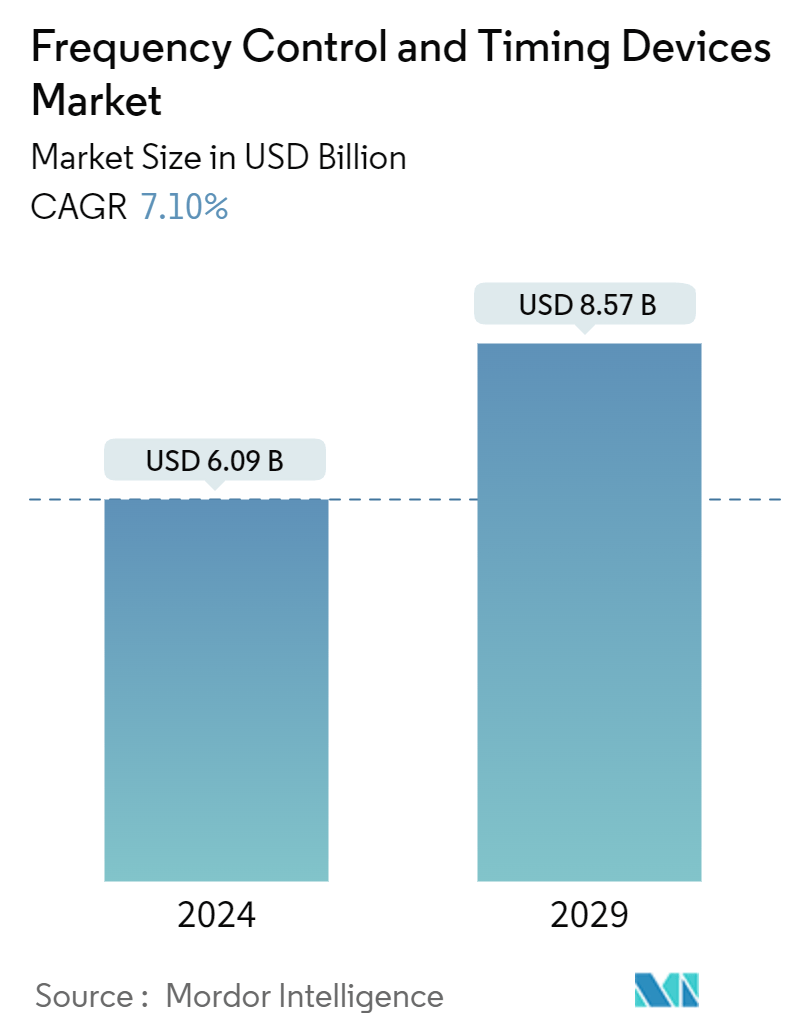
| Study Period | 2019 - 2029 |
| Market Size (2024) | USD 6.09 Billion |
| Market Size (2029) | USD 8.57 Billion |
| CAGR (2024 - 2029) | 7.10 % |
| Fastest Growing Market | Asia Pacific |
| Largest Market | Asia Pacific |
Major Players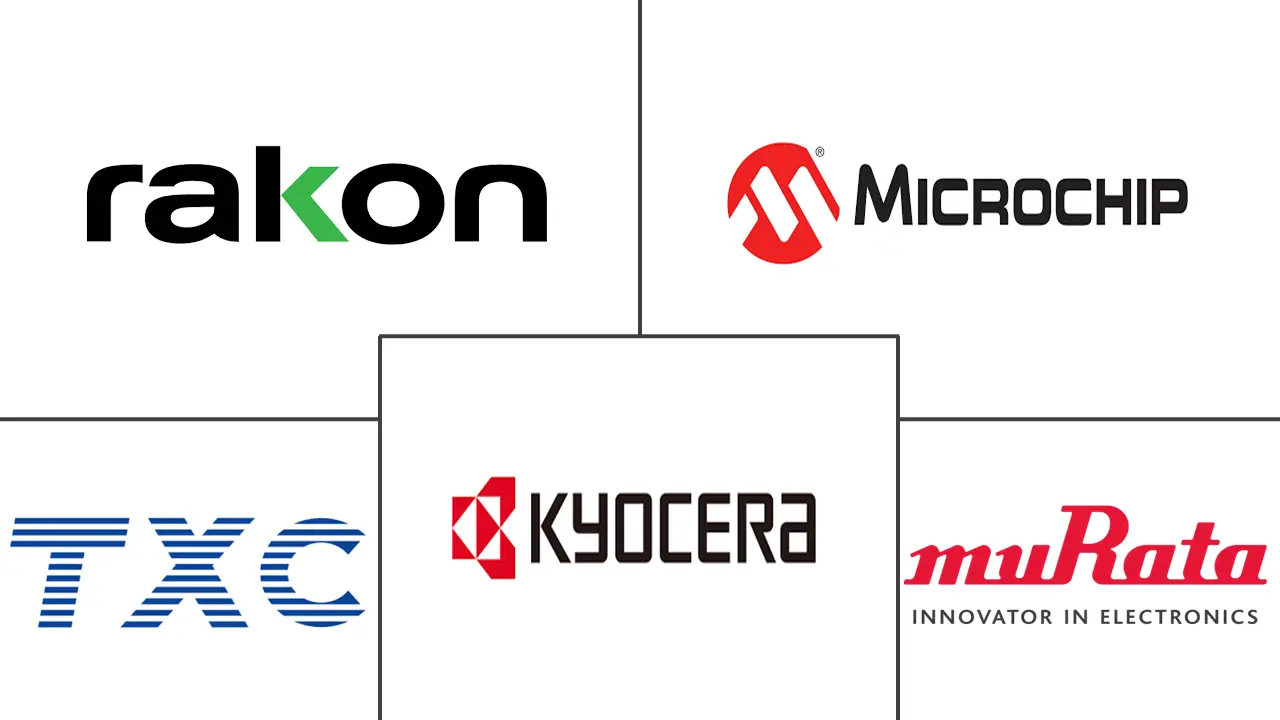
*Disclaimer: Major Players sorted in no particular order |
Frequency Control And Timing Devices Market Analysis
The Frequency Control And Timing Devices Market size is estimated at USD 6.09 billion in 2024, and is expected to reach USD 8.57 billion by 2029, growing at a CAGR of 7.10% during the forecast period (2024-2029).
Frequency control and timing devices (FCTD) are electronic components that generate, control, and synchronize timing signals in various electronic systems. They are crucial in ensuring accurate timing, synchronization, and coordination of operations within these systems. Applying the principles of timing devices to quartz crystals, MEMS, and ceramic resonators makes it possible to generate oscillations with stable frequencies. These timing devices help to ensure the precise operation of devices in Zigbee, Bluetooth, and other wireless applications (such as smartphones), automobiles, and medical equipment.
• The surging popularity of printed circuit boards (PCBs) is a key driver for the growth of the frequency control and timing devices market. Modern PCBs are becoming increasingly complex, with higher component density and functionality packed into smaller spaces. This complexity necessitates precise timing and signal integrity to ensure proper operation. FCTDs are important in managing these complexities by providing stable reference frequencies and signal integrity.
• Industrial organizations' efforts to accelerate digital transformation drive the market's growth. This includes shifting to the "industry 4.0" concept, which governs a higher adoption of automation, robotics, and advanced solutions such as AI and IIoT in industrial setups.
• The growing adoption of 5G technology worldwide significantly drives the growth of frequency control and timing devices. 5G networks utilize higher frequency bands, including millimeter-wave frequencies (24GHz and above), which require exact frequency control devices to maintain signal integrity and performance. With the expanded bandwidth capabilities of 5G, precise timing is essential to handle large amounts of data being transmitted and received, necessitating advanced oscillators and clock generators.
• The frequency control and timing devices market is a critical segment within the electronics industry, providing essential components for various applications. However, the high costs associated with developing and producing frequency control and timing devices are challenging the market's growth.
• Several macroeconomic trends, like economic growth, inflation, government spending priorities, global trade, and geopolitical dynamics, affect the defense budgets of various countries. According to the US Congressional Budget Office, defense spending in the United States is predicted to increase yearly until 2033. Defense outlays in the United States amounted to USD 746 billion in 2023, and the forecast predicts an increase to USD 1.1 trillion in 2033.
Frequency Control And Timing Devices Market Trends
Growth in the Construction Sector Boosting the Demand for Furniture Products
- Consumer electronics, frequency control, and timing devices find applications in smartphones and tablets, wearable devices, smart home devices, television and set-top boxes, gaming consoles, and digital cameras.
- Consumer electronics are becoming more compact, optimized for performance, and energy-efficient. These changes directly impact internal components such as crystals. Crystals are utilized in various products, including wearables, smartphones, PCs, gaming consoles, and TVs, to provide crucial timing signals for accurate data processing. Their reliability improves device performance and helps conserve energy, leading to extended battery life. This precision plays a vital role in establishing user confidence, driving the increasing popularity of wearables and other sophisticated electronics.
- The increase in smartphone adoption has played a key role in the market's growth. Crystal oscillators are essential in providing accurate timing signals for smartphones, tablets, and other electronic gadgets. As technology progresses and electronic components become smaller, crystal oscillators have become vital in ensuring optimal performance standards.
- According to Ericsson's mobility report, the continued strong uptake of 5G, with around 600 million new subscriptions added globally during 2023, shows that demand for high-performance connectivity remains resilient despite ongoing economic challenges and geopolitical unrest in some markets. As per Ericsson, the global 5G subscriptions are forecast to exceed 5.3 billion in 2029, making up 58% of all mobile subscriptions. It is also projected that North America and GCC will have the highest 5G penetration in 2029 at 92%, followed by Western Europe at 85%.
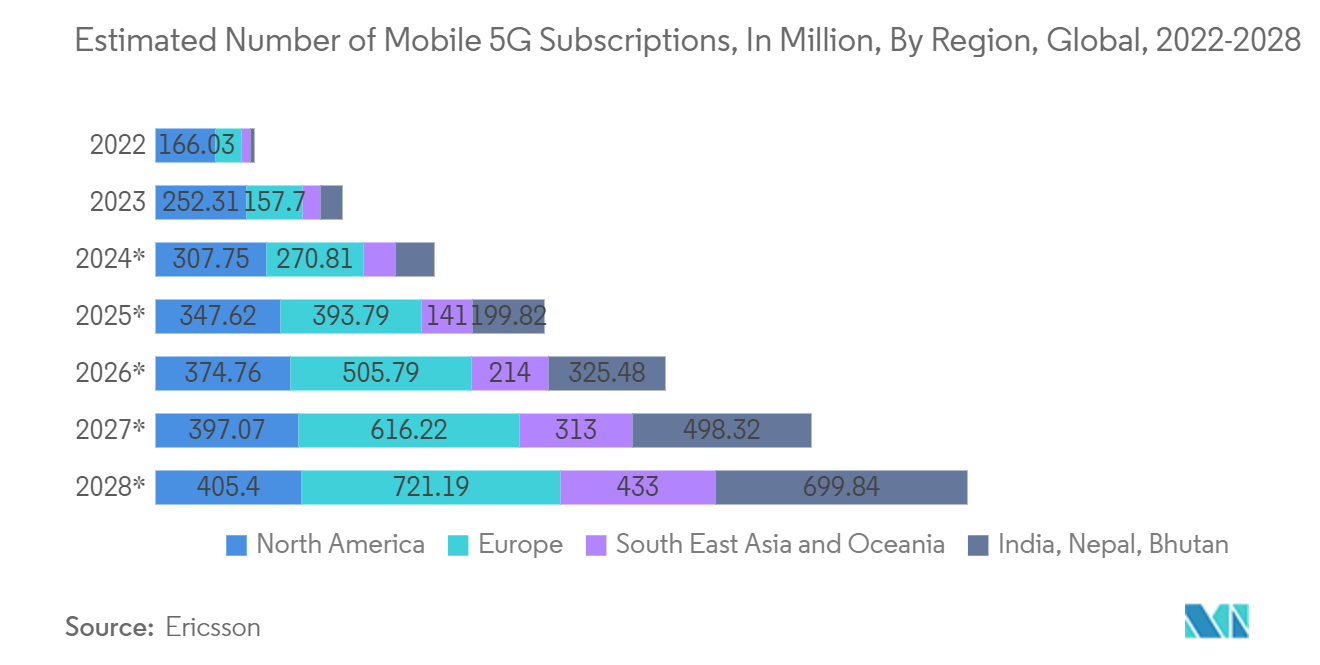
Asia-Pacific is Expected to Hold Significant Market Share
- The Asia-Pacific region is expected to witness rapid growth due to the rising number of smartphone consumers, data centers, rising adoption of 5G technology, industrial automation, etc., particularly in major economies like India and China. The recent advancements in crystal oscillators play a crucial role in enhancing overall efficiency and greatly improving accuracy in various applications.
- The Chinese smartphone industry is comprised of major players such as Huawei, Apple, Samsung, Xiaomi, and Lenovo. Most smartphone manufacturing facilities in China are in Guangdong Province, Beijing, Tianjin, and Shanghai. They are expected to sell significantly more smartphones in China in the coming years. This leads to the demand for crystal oscillators to improve the use of WiFi and Bluetooth combo chipsets in smartphone applications.
- In the Asia-Pacific region, South Korea holds a prominent position as a crucial market for frequency control and timing devices. This is primarily due to the extensive utilization of this technology by various industries in the country, such as consumer electronics, industrial robots, telecommunication equipment, and 5G services. These industries are recognized as major proponents of crystal oscillators.
- In addition, the escalating competition in the market has led to an increased production of electronic devices, further fueling the demand for crystal oscillators. Furthermore, the growing popularity of VCOs in the production of electronic music devices has also contributed significantly to this growth.
- The automotive sector across the region has witnessed significant growth in production, which fuels the market growth. Frequency control and timing devices are used in safety systems to provide accurate timing and synchronization. These systems include airbag deployment, anti-lock braking, electronic stability control, and collision avoidance systems.
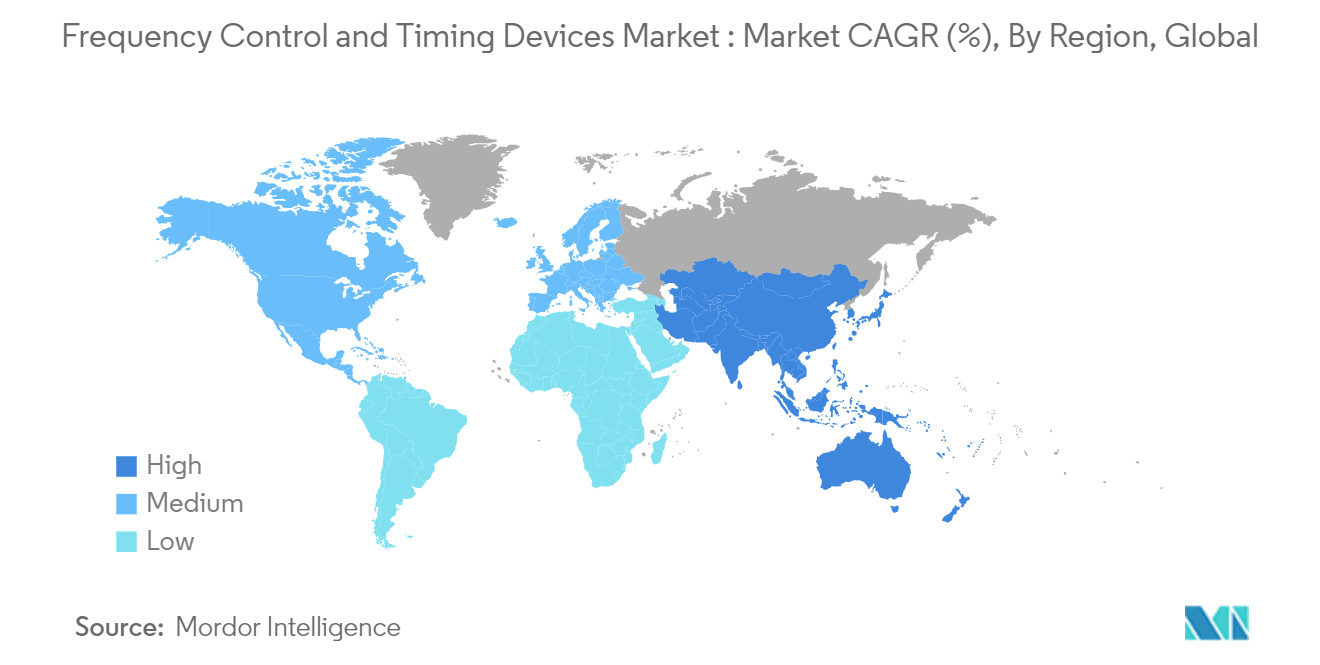
Frequency Control And Timing Devices Industry Overview
The frequency control and timing devices market is fragmented and highly competitive. The market appears to be highly fragmented, with significant players adopting strategies like product innovation, new product launches, partnerships, collaborations, and mergers and acquisitions. Some of the major players in the market are Murata Manufacturing Co. Ltd, Kyocera Corporation, Rakon Limited, Microchip Technology Inc., and TXC Corporation.
• April 2024 - Kyocera Avx, a manufacturer of advanced electronic components, unveiled a new manufacturing and design center for high-quality, low-noise quartz crystal frequency control products under the name Kyocera Avx Components Corporation (Erie). The newly established production facility is expected to manufacture over 1.2 million patented and unparalleled low-power OCXO (oven-controlled crystal oscillators) and a range of TCXO (temperature-computed crystal oscillators) and VCXO (voltage-computed crystal oscillators).
• February 2024 - Rakon displays its initial extended holdover solution for modern radio networks and telecommunications data centers at MWC Barcelona 2024. The Error Exchange OCXO (MercuryXE2) is a version of Rakon's recently launched Mercury compact IC-OCXO. It improves the system's current synchronization abilities on a network synchronizer evaluation board by incorporating frequency error exchange processing and aging compensation, thereby increasing the holdover performance.
Frequency Control And Timing Devices Market Leaders
-
Murata Manufacturing Co. Ltd
-
Kyocera Corporation
-
Rakon Limited
-
Microchip Technology Inc.
-
TXC Corporation
*Disclaimer: Major Players sorted in no particular order
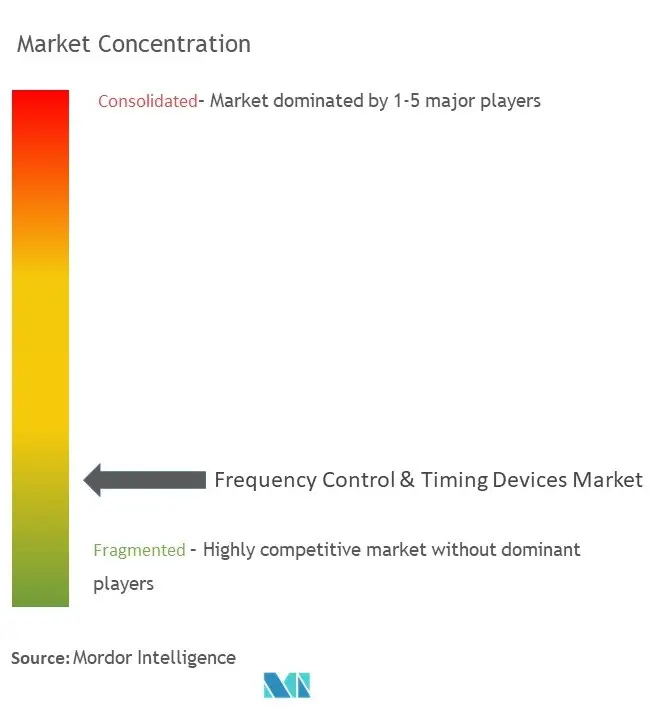
Frequency Control And Timing Devices Market News
- May 2024 - TXC Corporation introduced a new model of its ThermSym OCXO product known as the ThermSymChronos series. This product offers a highly stable solution with precision stability over temperature in a compact package. It serves as an outstanding reference clock to assist in achieving timing synchronization at the stratum 3E level in 5G network infrastructure. This includes components such as Radio Heads, Active Antenna Units (AAU), Small Cells, Distribute Units (DUs), Centralized Units (CUs), Base stations, Core Networks, Advanced Switches, Advanced Routers, and Internet Data Center (IDC).
- January 2024 - Rakon introduced its initial IC-OCXO items that feature the MercuryXbrand, which combines the mercury semiconductor chip designed in-house with XMEMS resonators. The mercury XOCXOs offer incredibly high stability and a prolonged holdover period of eight hours, even under real-world circumstances, all within a compact package size. These new OCXOs are ideal for timing and synchronization applications in AI computing/data centers, 5G advanced, and upcoming 6G telecommunications networks, as well as satellite terminals and instrumentation.
Frequency Control & Timing Devices Market Report - Table of Contents
1. INTRODUCTION
- 1.1 Study Assumptions and Market Definition
- 1.2 Scope of the Study
2. RESEARCH METHODOLOGY
3. EXECUTIVE SUMMARY
4. MARKET INSIGHTS
- 4.1 Market Overview
-
4.2 Industry Attractiveness - Porter's Five Forces Analysis
- 4.2.1 Bargaining Power of Buyers
- 4.2.2 Bargaining Power of Suppliers
- 4.2.3 Threat of New Entrants
- 4.2.4 Threat of Substitutes
- 4.2.5 Intensity of Competitive Rivalry
- 4.3 Value Chain Analysis
- 4.4 Analysis of Macroeconomic Trends on the Market
5. MARKET DYNAMICS
-
5.1 Market Drivers
- 5.1.1 Growing Adoption of 5G Across the World
- 5.1.2 Rising Demand from Advanced Automotive Applications
-
5.2 Market Challenges
- 5.2.1 High Cost of Development
6. MARKET SEGMENTATION
-
6.1 By Type
- 6.1.1 Crystals
- 6.1.2 Oscillators
- 6.1.2.1 Temperature Compensated Crystal Oscillator (TCXO)
- 6.1.2.2 Voltage-controlled Crystal Oscillator (VCXO)
- 6.1.2.3 Oven-controlled Crystal Oscillator (OCXO)
- 6.1.2.4 MEMS Oscillator
- 6.1.2.5 Other Types of Oscillators
- 6.1.3 Resonators
-
6.2 By End-user Industry
- 6.2.1 Automotive
- 6.2.2 Computer and Peripherals
- 6.2.3 Communications/Server/Data Storage
- 6.2.4 Consumer Electronics
- 6.2.5 Industrial
- 6.2.6 Military and Aerospace
- 6.2.7 Other End-user Industries
-
6.3 By Geography***
- 6.3.1 North America
- 6.3.2 Europe
- 6.3.3 Asia
- 6.3.4 Australia and New Zealand
- 6.3.5 Latin America
- 6.3.6 Middle East and Africa
7. COMPETITIVE LANDSCAPE
-
7.1 Company Profiles*
- 7.1.1 Murata Manufacturing Co. Ltd
- 7.1.2 Kyocera Corporation
- 7.1.3 Rakon Limited
- 7.1.4 Microchip Technology Inc.
- 7.1.5 TXC Corporation
- 7.1.6 Seiko Epson Corporation
- 7.1.7 Daishinku Corporation
- 7.1.8 Hosonic Technology (Group) Co. Ltd
- 7.1.9 Nihon Dempa Kogyo Co. Ltd
- 7.1.10 SiTime Corporation
- 7.1.11 SIWARD Crystal Technology Co. Ltd.
- 7.1.12 Texas Instruments Inc.
- 7.1.13 NXP Semiconductors
- 7.1.14 Abracon LLC
8. INVESTMENT ANALYSIS
9. MARKET OPPORTUNITIES AND FUTURE TRENDS
** Subject To AvailablityFrequency Control And Timing Devices Industry Segmentation
Frequency control and timing devices play a crucial role in electronic devices, providing signals that dictate the speed and timing of information transmission. They are instrumental in offering synchronizing signals and ensuring seamless operations in a variety of applications, including Zigbee, Bluetooth, smartphones, automobiles, and medical equipment.
The frequency control and timing devices market is segmented by type (crystals, oscillators (temperature compensated crystal oscillator (TCXO), voltage-controlled crystal oscillator (VCXO), oven-controlled crystal oscillator (OCXO), MEMS oscillator, and other types of oscillators), resonators), by end-user industry (automotive, computer and peripherals, communications/server/data storage, consumer electronics, industrial, military and aerospace, other end-user industries), and by geography (North America, Europe, Asia-Pacific, and the Rest of the World). The market sizes and forecasts are provided in terms of value (USD) for all the above segments.
| By Type | Crystals | |
| Oscillators | Temperature Compensated Crystal Oscillator (TCXO) | |
| Voltage-controlled Crystal Oscillator (VCXO) | ||
| Oven-controlled Crystal Oscillator (OCXO) | ||
| MEMS Oscillator | ||
| Other Types of Oscillators | ||
| Resonators | ||
| By End-user Industry | Automotive | |
| Computer and Peripherals | ||
| Communications/Server/Data Storage | ||
| Consumer Electronics | ||
| Industrial | ||
| Military and Aerospace | ||
| Other End-user Industries | ||
| By Geography*** | North America | |
| Europe | ||
| Asia | ||
| Australia and New Zealand | ||
| Latin America | ||
| Middle East and Africa |
Frequency Control & Timing Devices Market Research FAQs
How big is the Frequency Control And Timing Devices Market?
The Frequency Control And Timing Devices Market size is expected to reach USD 6.09 billion in 2024 and grow at a CAGR of 7.10% to reach USD 8.57 billion by 2029.
What is the current Frequency Control And Timing Devices Market size?
In 2024, the Frequency Control And Timing Devices Market size is expected to reach USD 6.09 billion.
Who are the key players in Frequency Control And Timing Devices Market?
Murata Manufacturing Co. Ltd, Kyocera Corporation, Rakon Limited, Microchip Technology Inc. and TXC Corporation are the major companies operating in the Frequency Control And Timing Devices Market.
Which is the fastest growing region in Frequency Control And Timing Devices Market?
Asia Pacific is estimated to grow at the highest CAGR over the forecast period (2024-2029).
Which region has the biggest share in Frequency Control And Timing Devices Market?
In 2024, the Asia Pacific accounts for the largest market share in Frequency Control And Timing Devices Market.
What years does this Frequency Control And Timing Devices Market cover, and what was the market size in 2023?
In 2023, the Frequency Control And Timing Devices Market size was estimated at USD 5.66 billion. The report covers the Frequency Control And Timing Devices Market historical market size for years: 2019, 2020, 2021, 2022 and 2023. The report also forecasts the Frequency Control And Timing Devices Market size for years: 2024, 2025, 2026, 2027, 2028 and 2029.
Frequency Control And Timing Devices Industry Report
The Frequency Control and Timing Devices Market Report provides an in-depth industry analysis segmented by type and end-user industry, covering various regions including North America, Europe, Asia-Pacific, and the Rest of the World. The market overview includes industry trends and market growth, highlighting the importance of different types of oscillators and resonators in various sectors such as automotive, consumer electronics, and military & aerospace.
The industry outlook and market forecast indicate a robust growth rate, driven by advancements in technology and increasing demand across multiple industries. The report also offers a comprehensive market segmentation, detailing the market size and market share of key players, as well as insights into market leaders and market predictions.
Industry reports and market data provide detailed industry statistics and market value, essential for understanding the current and future landscape of the timing devices market. The report example and report pdf serve as valuable resources for research companies and industry stakeholders, offering a thorough industry overview and market review.
The industry research includes crucial industry information and market trends, which are pivotal for making informed business decisions. The market outlook and market forecast are supported by extensive industry sales data, ensuring a well-rounded perspective on the market's potential.



